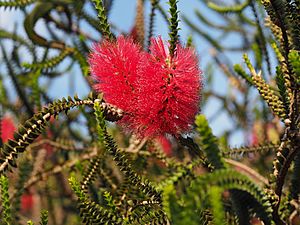Goldfields bottlebrush facts for kids
Quick facts for kids Goldfields bottlebrush |
|
|---|---|
 |
|
| M. coccinea leaves and flowers | |
| Scientific classification | |
| Genus: |
Melaleuca
|
| Species: |
coccinea
|
The Melaleuca coccinea, often called the goldfields bottlebrush, is a type of shrub. It is part of the myrtle family and grows only in the south of Western Australia. This plant is special because of its unusual leaves and bright red flowers that look like a bottlebrush.
Contents
What Does the Goldfields Bottlebrush Look Like?
The Goldfields bottlebrush can grow up to about 2 meters (6.5 feet) tall. It has many thin, tangled branches. Its leaves are arranged in pairs along the branches, with each pair at a right angle to the one below it. The leaves do not have a stalk. They are about 4.5 to 11 mm (0.2 to 0.4 inches) long and 2.5 to 5.5 mm (0.1 to 0.2 inches) wide. They are shaped like an egg or a heart, are slightly cupped, and have a pointed tip.
Flowers and Fruit
The flowers are a bright red color. They grow in bottlebrush-like spikes, which are about 40 to 80 mm (1.6 to 3.1 inches) long and 50 mm (2 inches) wide. These spikes appear on the side branches of the plant. The petals are small, about 3 to 4.5 mm (0.1 to 0.2 inches) long, and they fall off soon after the flower opens. The bright red color of the flowers comes from their many stamens. These stamens are grouped into five bundles, with each bundle having 11 to 15 stamens.
The Goldfields bottlebrush flowers during spring and summer. After the flowers, the plant produces fruit. These fruits are hairy, woody capsules that are about 3.5 to 5 mm (0.1 to 0.2 inches) long. They grow tightly together in a cylinder shape.
How the Goldfields Bottlebrush Got Its Name
The Melaleuca coccinea was first officially described in 1966 by a scientist named Alex George. He wrote about it in a publication called The Western Australian Naturalist. He found a sample of the plant about 32 miles (51 kilometers) east of Karonie, near the Trans-Australian Railway. It was growing in sandy soil over granite rock.
The second part of its scientific name, coccinea, is a Latin word. It means "deep red" or "crimson." This name was chosen because of the plant's beautiful red flowers.
Where the Goldfields Bottlebrush Grows
The Goldfields bottlebrush is found in the Kalgoorlie-Norseman area of Western Australia. This region includes the Coolgardie and Esperance areas. It likes to grow in sandy soil over granite, often near granite rock formations. You can also find it on sandplains and in river valleys.
Is the Goldfields Bottlebrush Endangered?
The Government of Western Australia Department of Parks and Wildlife lists this melaleuca as "not threatened." This means it is not currently in danger of disappearing.
Growing Goldfields Bottlebrush in Gardens
The Goldfields bottlebrush is considered a wonderful shrub for gardens. It has grown well in places like Brisbane and Perth. It prefers to be in full sun and needs soil that drains water well.
Images for kids
-
M. coccinea growing as a street tree in Ravensthorpe



